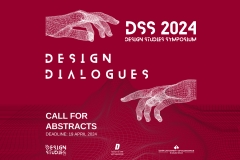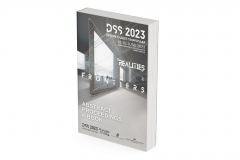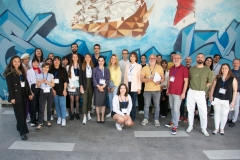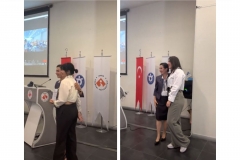
GRADUATE SCHOOL
Design Studies (With Thesis)
FFD 563 | Course Introduction and Application Information
| Course Name |
Art, Design and City
|
|
Code
|
Semester
|
Theory
(hour/week) |
Application/Lab
(hour/week) |
Local Credits
|
ECTS
|
|
FFD 563
|
Fall/Spring
|
3
|
0
|
3
|
7.5
|
| Prerequisites |
None
|
|||||
| Course Language |
English
|
|||||
| Course Type |
Elective
|
|||||
| Course Level |
Second Cycle
|
|||||
| Mode of Delivery | - | |||||
| Teaching Methods and Techniques of the Course | - | |||||
| Course Coordinator | ||||||
| Course Lecturer(s) | - | |||||
| Assistant(s) | - | |||||
| Course Objectives | This objective of this course is to understand and question the relationship between art, design and the city by taking the city as a social and physical entity. |
| Learning Outcomes |
The students who succeeded in this course;
|
| Course Description | To understand the discourses on the relationship between art, design and the city since modernism and to analyze a given urban space based on these. |
|
|
Core Courses | |
| Major Area Courses |
X
|
|
| Supportive Courses | ||
| Media and Management Skills Courses | ||
| Transferable Skill Courses |
WEEKLY SUBJECTS AND RELATED PREPARATION STUDIES
| Week | Subjects | Related Preparation |
| 1 | Introduction to the course | |
| 2 | Modernity and the City | Readings, Quiz 1 |
| 3 | Avant Garde Movements in Art and Architecture in the 20th and 21st century | Clement Greenberg (1989) “Avant-Garde and Kitsch” in Art and Culture Critical Essays, Beacon Press London / Quiz 2 |
| 4 | Public Art: Theories and Practice | Sharp, J., Pollock, V. and Paddison, R. (2005) ‘Just art for a just city: public art and social inclusion in urban regeneration’, Urban Studies 42(5/6), pp. 1001–1023. / Quiz 3 |
| 5 | Art, Culture and Urban Space in the Global Era | Malcolm Miles (2013) “Art and Culture: The Global Turn” in Re-imagining the City- ART, GLOBALIZATION AND URBAN SPACES eds. Elizabeth Grierson and Kristen Sharp/ Quiz 4 |
| 6 | Arts for Urban Regeneration and/or Gentrification? | Carl Grodach, Nicole Foster, James Murdoch (2015) “Arts industries do not cause gentrification- they tend to chase it.” blogs.lse.ac.uk/ / Quiz 5 |
| 7 | Art in the Making in the City: Art incubators, culture industry clusters in the city | Grodach, C. (2011). “Art spaces in community and economic development: Connections to neighborhoods, artists, and the cultural economy.” Journal of Planning Education and Research, 31, 74–85./ Quiz 6 |
| 8 | Urban Redevelopment through Arts: Miami Design District and Wynwood | Oner, A.C., Grant, R.J. and Tekel, A. (2016) “Global Arts Worlds and the Worlding of Wynwood, Florida” Presented at the 2016 American Association of Geographers (AAG) Conference. March 29-April 1st, 2016. San Francisco, CA. / Quiz 7 |
| 9 | City Case Studies: London Southbank and Shoreditch Representing the City through Art and Architectural Design: Art and culture venues, public art, street art | Report and Presentation |
| 10 | City Case Studies: Istanbul Cihangir, Karakoy, Galata, Beyoglu Representing the City through Art and Architectural Design: Art and culture venues, public art, street art | Report and Presentation |
| 11 | City Case Studies: Portland Pearl District and Alberta Arts District Representing the City through Art and Architectural Design: Art and culture venues, public art, street art | Report and Presentation |
| 12 | City Case Studies: Buenos Aires Palermo Soho and Palermo Hollywood Representing the City through Art and Architectural Design: Art and culture venues, public art, street art | Report and Presentation |
| 13 | City Case Studies: Sao Paulo Vila Madalena (Pinheiros District) and Jardins District Representing the City through Art and Architectural Design: Art and culture venues, public art, street art | Report and Presentation |
| 14 | Art and Design in Izmir: Getting Ready for the Final Project • How has Izmir been represented through art and design historically and in the recent times in different artictic mediums? • What are the important public art and venues in Izmir? • Where is art exhibitied in Izmir? • Where is art produced in Izmir? • Is there a cluster for art and culture industry in Izmir? • How is the built environment appropriated to the art, design and cultural production in Izmir? | Final Report and Presentation |
| 15 | Review of the Semester | |
| 16 | Review of the Semester |
| Course Notes/Textbooks | Clement Greenberg (1989) “Avant-Garde and Kitsch” in Art and Culture Critical Essays, Beacon Press London - - - Sharp, J., Pollock, V. and Paddison, R. (2005) ‘Just art for a just city: public art and social inclusion in urban regeneration’, Urban Studies 42(5/6), pp. 1001–1023. - - - Malcolm Miles (2013) “Art and Culture: The Global Turn” in Re-imagining the City- ART, GLOBALIZATION AND URBAN SPACES eds. Elizabeth Grierson and Kristen Sharp - - - Carl Grodach, Nicole Foster, James Murdoch (2015) “Arts industries do not cause gentrification- they tend to chase it.” blogs.lse.ac.uk/ - - - Grodach, C. (2011). “Art spaces in community and economic development: Connections to neighborhoods, artists, and the cultural economy.” Journal of Planning Education and Research, 31, 74–85. - - - Oner, A.C., Grant, R.J. and Tekel, A. (2016) “Global Arts Worlds and the Worlding of Wynwood, Florida” Presented at the 2016 American Association of Geographers (AAG) Conference. March 29-April 1st, 2016. San Francisco, CA. |
| Suggested Readings/Materials | Georg Simmel (1903), “The Metropolis and Mental Life,” Kurt Wolff (trans.) The Sociology of Georg Simmel (New York: Free Press, 1950), 409424; Christopher Crouch, Modernism in Art, Design and Architecture (New York: St. Martin’s Press, 1999), “The Cultural Background to the Machine Age”, 1028; Hide Heynen, “New Babylon: The Antinomies of Utopia,” Assemblage, No. 29 (Apr., 1996): 2439; Rosalyn Deutsche, “Uneven Development: Public Art in New York City,” October 47 (Winter, 1988): 352; Anthony Vidler, Warped Space: Art, Architecture, and Anxiety in Modern Culture (Cambridge, Massachusetts: The MIT Press, 2001), “Agoraphobia”, 2550; Beatriz Colomina, “The Split Wall: Domestic Voyeurism,” in B. Colomina (ed.), Sexuality & Space (Princeton Architectural Press, 1992), 7398; Kristine Nielsen, “What Ever Happened to Ernst Barlach? East German Political Monuments and the Art of Resistance,” in Totalitarian Art and Modernity, eds. Mikkel Bolt Rasmussen and Jacob Wamberg (Aarhus: Aarhus Univ. Press, 2010), 147169; Leo OuFan Lee, “Shanghai Modern: Reflections on Urban Culture in China in the 1930s,” Public Culture 11, No. 1 (1999): 75107.; Ronald Lee Fleming “The Art of Placemaking: Interpreting Community Through Public Art and Urban Design” (Merrell Publishers, 2007); Harriet Senie “Critical Issues in Public Art: Content, Context, and Controversy” (Smithsonian Books, 1998); Cher Krause Knight “Public Art: Theory, Practice and Populism” (Wiley-Blackwell, 2008); Antawan I. Byrd and Reid Shier “Art Cities of the Future: 21st-Century Avant-Gardes” (Phaidon Press, 2013) |
EVALUATION SYSTEM
| Semester Activities | Number | Weigthing |
| Participation |
1
|
5
|
| Laboratory / Application | ||
| Field Work | ||
| Quizzes / Studio Critiques | ||
| Portfolio | ||
| Homework / Assignments |
1
|
35
|
| Presentation / Jury |
2
|
20
|
| Project |
1
|
40
|
| Seminar / Workshop | ||
| Oral Exams | ||
| Midterm | ||
| Final Exam | ||
| Total |
| Weighting of Semester Activities on the Final Grade |
5
|
100
|
| Weighting of End-of-Semester Activities on the Final Grade | ||
| Total |
ECTS / WORKLOAD TABLE
| Semester Activities | Number | Duration (Hours) | Workload |
|---|---|---|---|
| Theoretical Course Hours (Including exam week: 16 x total hours) |
16
|
3
|
48
|
| Laboratory / Application Hours (Including exam week: '.16.' x total hours) |
16
|
0
|
|
| Study Hours Out of Class |
14
|
7
|
98
|
| Field Work |
0
|
||
| Quizzes / Studio Critiques |
0
|
||
| Portfolio |
0
|
||
| Homework / Assignments |
1
|
21
|
21
|
| Presentation / Jury |
2
|
6
|
12
|
| Project |
1
|
46
|
46
|
| Seminar / Workshop |
0
|
||
| Oral Exam |
0
|
||
| Midterms |
0
|
||
| Final Exam |
0
|
||
| Total |
225
|
COURSE LEARNING OUTCOMES AND PROGRAM QUALIFICATIONS RELATIONSHIP
|
#
|
Program Competencies/Outcomes |
* Contribution Level
|
||||
|
1
|
2
|
3
|
4
|
5
|
||
| 1 | to be able to expand the practical knowledge gained in undergraduate programs with theoretical field of design research, |
X | ||||
| 2 | to be able to examine, interpret data and assess concepts and ideas with research methods of design theory and social sciences, |
X | ||||
| 3 | to be able to identify problems of design disciplines in times of global / environmental crisis and to be able to develop possible solutions for design practitioners, |
X | ||||
| 4 | to be able to expand knowledge on the history of material culture as it relates to design practices of the past, |
X | ||||
| 5 | to be able to promote research on local practices of everyday life and assess the outcome to implement design solutions, |
X | ||||
| 6 | to be able to facilitate interactions in between varied design disciplines and to promote collaborative work to solve complex problems, |
X | ||||
| 7 | to be able to process outcome of design research to be applied in design education, |
X | ||||
| 8 | to be able to instigate research on the new tools, technologies and materials of production in order to accelerate changes in design practices, |
X | ||||
| 9 | to be able to develop an ethical approach towards design professions in order to install social and environmental responsibilities, |
X | ||||
| 10 | to be able to use a foreign language for both chasing the scientific publication and developing proper communication with colleagues from other countries, in written and verbal ways. |
X | ||||
| 11 | to be able to use computer programs needed in the field design as well as information and communication technologies in advanced levels (“European Computer Driving Licence”, Advanced Level”). |
X | ||||
*1 Lowest, 2 Low, 3 Average, 4 High, 5 Highest
NEWS |ALL NEWS

DSS 2024 CALL FOR PAPERS | THEME: DESIGN DIALOGUES
DSS 2024 CALL FOR PAPERS THEME: DESIGN DIALOGUES The Design Studies Graduate Program and the Faculty of Fine Arts and Design at the Izmir

Abstract Proceedings e-Book for the Design Studies Symposium 2023 is available now!
The Design Studies Symposium 2023 (DSS 2023), organized in collaboration with İzmir University of Economics Graduate School Design Studies Master's and PhD

Design Studies Symposium 2023: Realities & Frontiers
The Design Studies Symposium 2023 (DSS 2023) organized by the IEU Graduate School Design Studies programs was held on 1-2 June, at

The Best Paper Award at the Design Studies Symposium 2023: Realities & Frontiers
The voting for the best presentation award at the Design Studies Symposium 2023 (DSS 2023) organized by the IEU Graduate School Design




